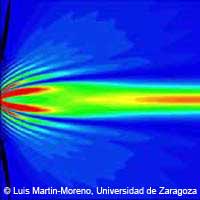| Posted: January 18, 2007 |
Plasmon enhanced photonics - new science lights up European research |
|
(Nanowerk News) Already a world leader in the science of photonics, the technology of transmitting light particles or photons to carry information through fibre optics, Europe is now set to climb to new heights in the novel field of plasmonics.
|
|
Through the Sixth Framework Programme (FP6), the EU is putting its weight behind two strategic research projects (STREPs) and one Network of Excellence looking at plasmonics, or 'light on a wire', which will allow the transmission of data at optical frequencies along the surface of a very small metal wire.
|
 |
|
The €3.88 million research project PLEAS, for "Plasmon Enhanced Photonics", is aiming to make plasmonics a key element in the future of the European photonics industry. To achieve this goal it is bringing together academics from five universities and two major industry players to look at controlling light in metals at the nano scale.
|
|
According to project leader Ross Stanley from the Swiss Centre for Electronics and Microtechnology (CSEM SA), "The European research community is the world leader in almost every area of plasmon research. The huge potential of plasmons had not previously been supported adequately by the photonics industry. In this project, we have the top plasmon experts sitting around the same table as two major players from the European photonics industry, explaining their vision."
|
|
"Thanks to EU funding, we now have a unique opportunity to implement this vision," he added.
|
|
The project has two main aims, according to the industrial partners. On the one hand, Osram Opto Semiconductor, a leader in high performance LED design and manufacture, is interested in plasmonics as a way of achieving higher energy efficiency LEDs.
|
|
Mr Stanley says: "We aim to improve these devices' efficiencies by at least 20%, so that a premium LED that is already typically 35% efficient can be improved to have an efficiency nearer 50%."
|
|
On the other hand, Sagem Défense Sécurité, a key player in vision-based security, is keen to develop higher sensitivity photo detectors that will lead to cheaper and more powerful cameras.
|
|
The academic and research partners include the Autonomous University of Madrid, the University of Zaragoza, Queens University Belfast, the Technical University of Dresden, and the Louis Pasteur University in Strasburg.
|

